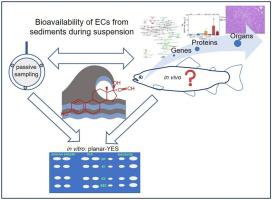Aquatic Toxicology ( IF 4.1 ) Pub Date : 2020-12-09 , DOI: 10.1016/j.aquatox.2020.105719 Anne-Katrin Müller , Nele Markert , Katharina Leser , David Kämpfer , Sabrina Schiwy , Carolin Riegraf , Sebastian Buchinger , Lin Gan , Ali T. Abdallah , Bernd Denecke , Helmut Segner , Markus Brinkmann , Sarah E. Crawford , Henner Hollert

|
Numerous environmental pollutants have the potential to accumulate in sediments, and among them are endocrine-disrupting chemicals (EDCs). It is well documented that water-borne exposure concentrations of some potent EDCs, more specifically estrogenic- active compounds (ECs), can impair the reproduction of fish. In contrast, little is known about the bioavailability and effects of sediment-associated ECs on fish. Particularly, when sediments are disturbed, e.g., during flood events, chemicals may be released from the sediment and become bioavailable. The main objectives of this study were to evaluate a) whether ECs from the sediment become bioavailable to fish when the sediment is suspended, and b) whether such exposure leads to endocrine responses in fish. Juvenile rainbow trout (Oncorhynchus mykiss) were exposed over 21 days to constantly suspended sediments in the following treatments: i) a contaminated sediment from the Luppe River, representing a “hotspot” for EC accumulation, ii) a reference sediment (exhibiting only background contamination), iii) three dilutions, 2-, 4- and 8-fold of Luppe sediment diluted with the reference sediment, and iv) a water-only control. Measured estrogenic activity using in vitro bioassays as well as target analysis of nonylphenol and estrone via LC–MS/MS in sediment, water, fish plasma, as well as bile samples, confirmed that ECs became bioavailable from the sediment during suspension. ECs were dissolved in the water phase, as indicated by passive samplers, and were readily taken up by the exposed trout. An estrogenic response of fish to Luppe sediment was indicated by increased abundance of transcripts of typical estrogen responsive genes, i.e. vitelline envelope protein α in the liver and vitellogenin induction in the skin mucus. Altered gene expression profiles of trout in response to suspended sediment from the Luppe River suggest that in addition to ECs a number of other contaminants such as dioxins, polychlorinated biphenyls (PCBs) and heavy metals were remobilized during suspension. The results of the present study demonstrated that sediments not only function as a sink for ECs but can turn into a significant source of pollution when sediments are resuspended as during flood-events. This highlights the need for sediment quality criteria considering bioavailability sediment-bound contaminants in context of flood events.
中文翻译:

虹鳟(Oncorhynchus mykiss)悬浮沉积物中的雌激素化合物的生物利用度及其影响。
许多环境污染物都有可能在沉积物中积累,其中包括破坏内分泌的化学物质(EDC)。有充分的证据表明,某些有效EDC(尤其是雌激素活性化合物(EC))的水传播浓度会损害鱼类的繁殖。相反,对与沉积物相关的EC对鱼类的生物利用度和影响知之甚少。特别是,当沉积物受到干扰时,例如在洪水事件期间,化学物质可能会从沉积物中释放出来并变为可生物利用的。这项研究的主要目的是评估a)悬浮沉积物时,沉积物中的ECs是否对鱼类具有生物利用性; b)这种暴露是否会导致鱼类的内分泌反应。少年虹鳟鱼(Oncorhynchus mykiss)在以下处理过程中经过21天暴露于不断悬浮的沉积物中:i)来自卢普河的被污染沉积物,是EC积累的“热点”,ii)参考沉积物(仅显示背景污染),iii)三种稀释度,用参考沉积物稀释的Luppe沉积物的2倍,4倍和8倍,以及iv)仅用水的对照。使用体外测得的雌激素活性生物分析以及通过沉淀物,水,鱼血浆和胆汁样品中的LC-MS / MS对壬基酚和雌酮进行目标分析,证实了悬浮液中ECs可从沉积物中获得生物利用度。如无源采样器所示,ECs溶解在水相中,并很容易被裸露的鳟鱼吸收。典型的雌激素响应基因(卵黄蛋白包膜蛋白α)的转录本增加,表明鱼类对Luppe沉积物的雌激素响应在肝脏和卵黄蛋白原中诱导皮肤粘液。响应卢普河中的悬浮沉积物,鳟鱼的基因表达谱发生了变化,这表明,除了EC外,悬浮过程中还迁移了其他污染物,例如二恶英,多氯联苯(PCB)和重金属。本研究的结果表明,沉积物不仅充当EC的汇,而且在洪灾期间将悬浮物重新悬浮时,可能成为重要的污染源。这突显了在洪水事件的背景下需要考虑生物有效性的沉积物质量标准。











































 京公网安备 11010802027423号
京公网安备 11010802027423号